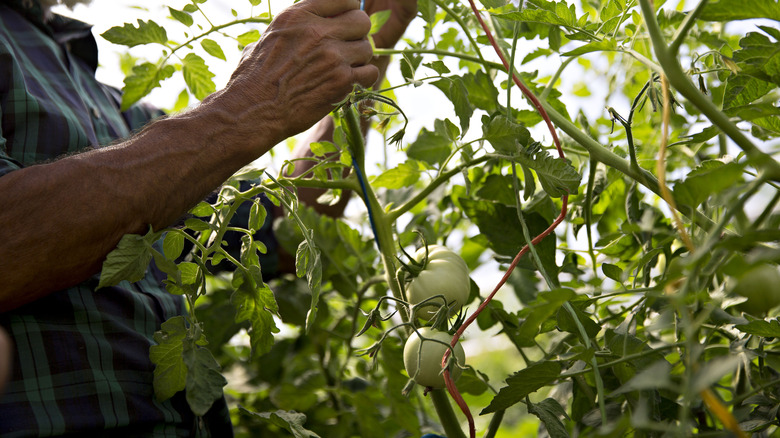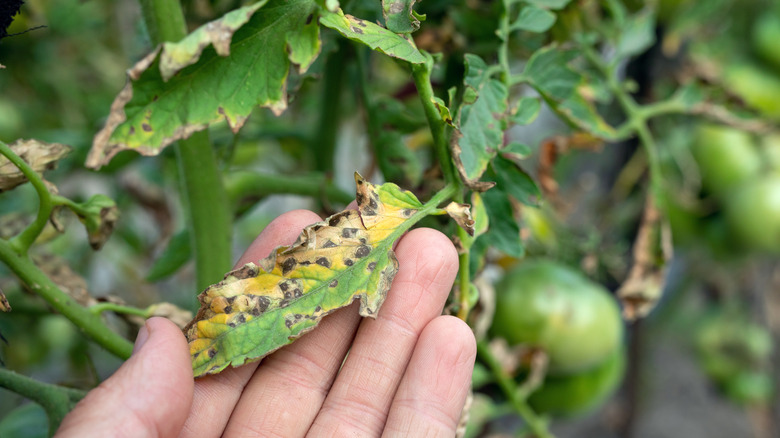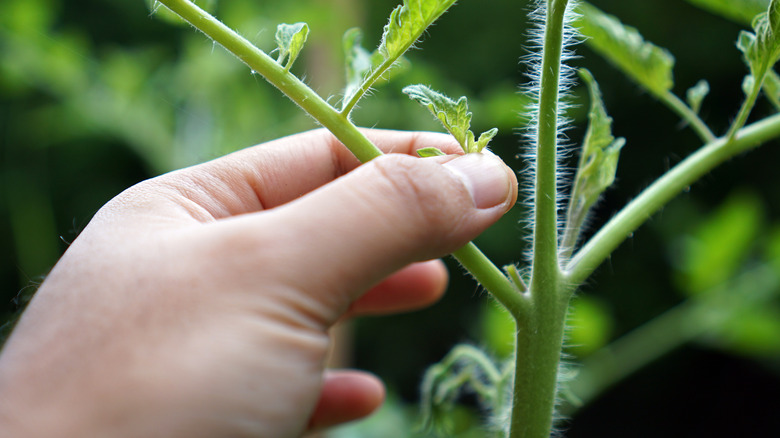Reasons Why Your Tomato Plant Has Curling Leaves
Tomato plants are a classic summer garden staple. They are relatively easy to grow and produce a bountiful crop — especially considering the low level of effort needed to maintain a plant or two. That all being said, tomatoes, like all garden plants, are susceptible to pests and diseases that can quickly decimate your plant if not addressed promptly. One pesky problem that plagues many gardeners is curling leaves on tomato plants. Whether it's one stalk, limited to new growth, or covering the entire plant, curling leaves are a sign that your tomato plant needs attention.
While curling leaves are definitely a sign of an issue, unfortunately, they could be related to several factors. High temperatures — particularly combined with low humidity — can cause tomato plant leaves to curl as a protective response to reduce water loss. Additionally, exposure to strong winds or excessive sunlight can lead to leaf curling. At the same time, certain pests like aphids, whiteflies, or spider mites can infest tomato plants and cause leaf curling as a result of feeding damage. Similarly, diseases such as tomato mosaic virus or curly top virus can cause leaves to curl and distort. Finally, a lack of essential nutrients — particularly calcium, magnesium, or potassium — can lead to leaf curling. Conversely, excessive nitrogen can also cause leaf curling.
How to save your tomatoes from curling leaves
To save a tomato plant from curling leaves, first identify and address the underlying cause of the issue. Examine the leaves for any signs of pests, diseases, or nutrient deficiencies. Look for visible pests like aphids as well as symptoms of diseases such as discoloration or spots on the leaves. Additionally, consider environmental factors like temperature, humidity, and sunlight exposure. If environmental stress is the cause of leaf curling, seek to mitigate the problem. Provide shade during the hottest parts of the day, ensure adequate ventilation, and increase humidity by misting the leaves. Shield the plants from strong winds that can further stress the foliage.
If pests are present, use appropriate pest control methods. This can include organic options like insecticidal soap, neem oil, or introducing beneficial insects like ladybugs. For diseases, identify the specific issue and treat it accordingly. Fungicides or bactericides may be necessary, depending on the disease.
Conduct a soil test to determine if any nutrient deficiencies or imbalances exist. Adjust the soil pH as necessary and provide proper fertilization based on the results. For calcium deficiency, add crushed eggshells or gypsum to the soil. Ensure a balanced nutrient profile, paying attention to calcium, magnesium, and potassium levels. Additionally, make sure to maintain consistent watering practices, as inconsistent watering can contribute to leaf curling. Water the plants deeply but less frequently, allowing the soil to dry out slightly between watering sessions. Ensure proper drainage to prevent waterlogged conditions.
How to prune for healthy tomato plants
Believe it or not, too much pruning can also lead to leaf curling on your tomato plant. While pruning is important to maintain the well-being of your vegetation, it should be done with proper care to foster healthy growth. Start pruning your tomato plant once it has grown a few sets of leaves and has established a strong root system. Typically, this is done when the plant is around 6 to 12 inches tall.
Solanum lycopersicums are prone to suckers, which are the small shoots that emerge where the branches meet the stem, diverting important energy away from the main herb. Remove suckers using clean pruning shears. Start by removing the lower suckers first, as they have less potential for growth and fruit production. Leave a few suckers at the top of the plant if desired for additional branching. Another good pruning tip is to remove excess foliage. Trim any yellowing or diseased leaves — or leaves that touch the ground, as they can increase the risk of soil-based diseases. Removing this extra foliage improves airflow around the vegetation and reduces the risk of fungal infections.
Different tomato varieties have different growth habits, so adjust your pruning techniques accordingly. Pruning can be a personal preference and may vary based on the desired shape and size of the Lycopersicon esculentum. Proper pruning practices, combined with appropriate care and maintenance, can help support your tomato plants.


